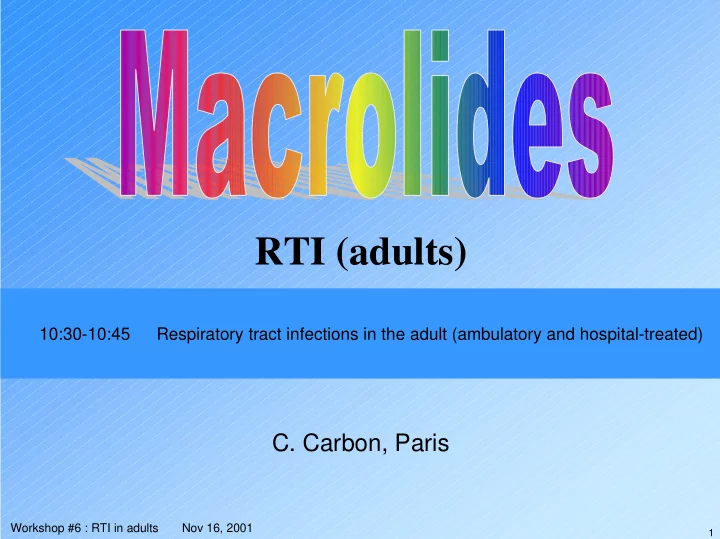

RTI (adults) 10:30-10:45 Respiratory tract infections in the adult (ambulatory and hospital-treated) C. Carbon, Paris Workshop #6 : RTI in adults Nov 16, 2001 1
Macrolides in RTIs: Adult patients Claude Carbon Division des Maladies Infectieuses CHUV; CH-Lausanne Workshop #6 : RTI in adults Nov 16, 2001 2
Introduction • Major source of AB use: 67% (Garau, 2001) • 1/6 physician visits in US or Canada . (Gonzales, 1997). • France: frequency of Dg and AB-Rx RTIs increased by 86% in adults in a 10-y period (Guillemot, 1998) • Vast majority of viral origin. • High % of undue courses of AB Workshop #6 : RTI in adults Nov 16, 2001 3
Major pathogens • URTIs: Streptococcus pneumoniae, Haemophilus influenzae , group A strep. • LRTIs: S.pneumoniae, H.influenzae, Moraxella catarrhalis, intracellular pathogens • All are within the spectrum of activity of M. • Drawbacks: resistance (R), poor intrinsic activity against H. inf ., lack of cidal effect. • Impacts of R: risk of failure (Garau, 2001); reconsideration of M as first line choice. Workshop #6 : RTI in adults Nov 16, 2001 4
Clinical use of M in RTIs • Frequent drawbacks in clinical studies: Dg, assessment of severity, lack of power… • Sinusitis: 90% maxillary; > 50% self- limited.( Williams, 1999 ) • M no longer considered as first choice. • Bronchitis: *acute: no AB Rx. *AECB:AB restricted to the most severe cases. Efficacy of M compromised by R of S.pneumoniae Workshop #6 : RTI in adults Nov 16, 2001 5
AECB • Ery. mentioned as one of the first line choice only in US recommendations, and as a second line choice in European guidelines (Ball, 1998) • Poor effect against H.influenzae (failure; persistence) ( Davies, 1989; Beghi, 1995 ) • Main problem: to restrict AB use to pts with the most severe presentations Workshop #6 : RTI in adults Nov 16, 2001 6
Community-acquired pneumonia • Common practices in Europe (Huchon, 1996): – F/UK: β -lactams; E: M; D:Tc; I: 3-CSP • Good evaluation of severity (Schaberg, 1996; Fantin, 2001; Bochud, 2001) • Contradictory evaluation of the impact of guidelines:clinical/economical outcomes • 4 classes of Pts: risk factors, severity and prediction of mortality(ATS,1993) Workshop #6 : RTI in adults Nov 16, 2001 7
CAP: Guidelines • US/Canada:M = one of the first line choice for group 1. Combined with other AB in the other groups .(Bartlett, 2000; Mandell, 2000) • Europe ( Woodhead, 1998 ): – non severe CAP: F:amox or M ; I: β L ± M; UK:amox; E: penicillin or M – severe CAP: F: coamox (or 3CSP) + M; I/E: 3CSP + M; UK: 2CSP + M Workshop #6 : RTI in adults Nov 16, 2001 8
Comments • In outpatients: M cannot be recommended as monotherpy if any risk of S.pneumoniae . First group of ATS. • In elderly: FQ, or 2CSP (3CSP) + M: reduced mortality at d 30 vs other regimens (Gleason, 1999) • Low cost AB not necessarily associated with poor outcomes (Gilbert, 1998) Workshop #6 : RTI in adults Nov 16, 2001 9
Which macrolide (I) ? • Ery. = reference. Poor validation of some concepts (targeted AB, synergy C/OH-C) (Carbon 2001) • With some compounds ( M16, dirithromycin ) limited evaluation of efficacy(severe cases, bacteremia). No studies vs FQ against Legionella . M less cidal ( Edelstein, 1998) • Azi. not convenient for bacteremic patients ( Fogarty , 1998 ) failure of Roxi. to cure H. influenzae ( Ortqvist, 1996) Workshop #6 : RTI in adults Nov 16, 2001 10
Which macrolide (II) ? • Basis for choice: – Rx habits; tolerance; drug interactions; extracellular concentrations; R patterns: 16 M vs 14-15 M? Little is known about the consequences of R profile vs efficacy of 16 M and of their overuse on R. (Klugman, 1998) • Risks of underdosing (limited adaptability) and risks of increased selection of R with long acting compounds ( Baquero,1999 ) Workshop #6 : RTI in adults Nov 16, 2001 11
Ketolides • Telithromycin. 800mg OD. • Six phase III studies in CAP: 3 comparative (Amox, trova, clari), 3 non comparative. • 1400 pts treated with T. 90% clinical cure; 90.5% bacteriological cure.( Carbon, 2001) • No impact of age, severity, bacteremia. • Limits: small numbers of Ery R S.pn. • Effect vs H.infl .? Impact of R mechanisms ? Workshop #6 : RTI in adults Nov 16, 2001 12
Conclusions • M cannot be longer considered as first line monotherapy for Rx of RTIs in adults.16 M to be better investigated. Significant threshold of R ? • Ketolides represent a potential alternative. • Newest FQ competitors for single drug Rx in CAP • Need for improving Dg, restricting AB indications. Workshop #6 : RTI in adults Nov 16, 2001 13
Recommend
More recommend